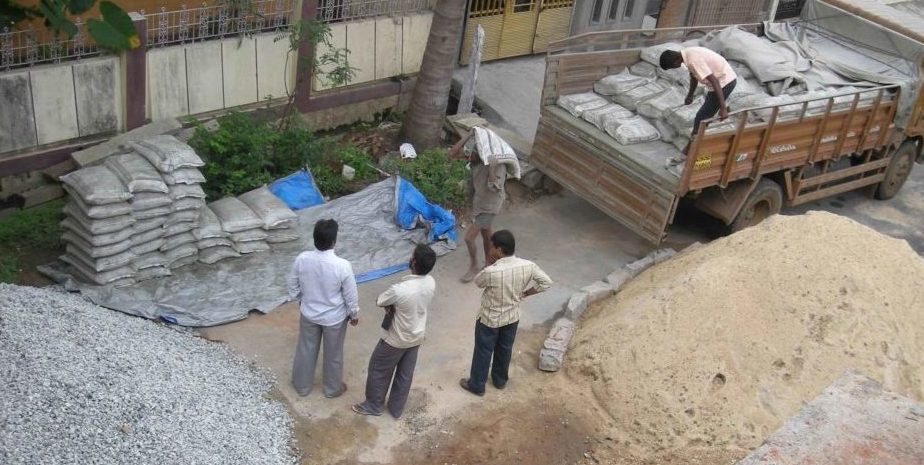Understanding the correct calculating methodology and knowing the precise quantity of materials is important to achieve the proper relative proportion of cement, sand, aggregate, and water for producing high-quality concrete. This comprehensive article offers straightforward methods to determine the exact amounts of cement, sand, aggregate, and water needed to attain different concrete grades, including M5, M7.5, M10, M15, and M20.
Elevate the quality of your concrete projects with our expert insights, empowering you to confidently create exceptional structures. Our calculations have been verified against respected standards like IS456, IS10262, and the government’s “Rate of Analysis,” ensuring reliability and accuracy.

Understanding Concrete Grades:
Concrete grades are named according to their strength and performance. The letter “M” in the grade stands for “mix,” and the number after “M” represents the expected compressive strength after 28 days of water curing. Some commonly used Nominal Mix grades are M5, M7.5, M10, M15, and M20.
To illustrate, let’s consider M20 grade concrete. After undergoing 28 days of water curing, this particular grade will possess a compressive strength of 20 N/mm2. The compressive strength is a crucial parameter that determines the durability and load-bearing capacity of the concrete.
Concrete Mix Ratio Explained:
Concrete mix ratio refers to the specific proportions of cement, sand, aggregate, and other components required to create different concrete grades. The nominal mix ratio for M20 Concrete, for instance, is 1:1.5:3. This means that for each part of cement, 1.5 parts of sand and 3 parts of aggregate are necessary to produce M20 grade concrete.
Difference Between Nominal Mix Ratio and Design Mix Ratio:
Nominal mix ratios are predetermined volumetric ratios suitable for on-site concrete mixing, while Design mix ratios are calculated weight ratios utilized for large-scale production in RMC plants or laboratories.
Nominal mixes are convenient for preparing smaller to medium quantities of concrete, whereas Design mixes follow the IS10262 codebook guidelines for precise mix proportions.
Nominal Concrete Mix Ratio for Different Grades of Concrete:
A table is provided with the recommended nominal concrete mix ratios for different grades, including M5, M7.5, M10, M15, and M20. These ratios indicate the proportions of cement, sand, and aggregate necessary to attain the desired compressive strength of the concrete.
| Concrete Grade | Nominal Mix Ratio (Cement : Sand : Aggregate) | Compressive Strength |
| M5 | 1:5:10 | 5 N/mm2 |
| M7.5 | 1:4:8 | 7.5 N/mm2 |
| M10 | 1:3:6 | 10 N/mm2 |
| M15 | 1:2:4 | 15 N/mm2 |
| M20 | 1:1.5:3 | 20 N/mm2 |
It’s important to note that engineers may occasionally make slight adjustments to these ratios based on specific project requirements. For instance, they might increase the sand content to improve workability or reduce the cement content to control costs. However, significant modifications beyond the prescribed proportions can impact the strength and overall quality of the concrete.
Calculation Methods:
Two straightforward methods are employed by civil engineers to determine the quantities of cement, sand, and aggregate for concrete production.
- Method 1 involves using the recommended nominal concrete mix ratio to calculate the volume of each component.
- Method 2 utilizes the total aggregate value specified in the IS codebook to determine the weight of sand and coarse aggregate needed per 50 kg bag of cement.
Calculation of Cement, Sand, and Aggregate from Nominal Mix Ratio:
During the mixing process of cement, sand, and aggregate, it is important to consider the initial space occupied by cement and sand in between the coarse aggregate particles before they settle into their own spaces. This phenomenon leads to a requirement of more than 1 cubic meter of dry ingredients to produce 1 cubic meter of concrete.
Through standard practices among engineers and the trial-and-error method, it has been determined that the “Total dry volume” of cement, sand, and aggregate needed to create 1 cubic meter of M20, M15, and M10 grade concrete is 1.57 cubic meters. Similarly, the “Total dry volume” of ingredients for 1 cubic meter of M7.5 and M5 grade concrete is 1.52 cubic meters.
It is worth noting that various websites may provide different values for the “Total dry volume” in their calculations. The values mentioned above have been personally verified multiple times and align with the analysis rates provided by government sources.
Calculating Cement, Sand and Coarse aggregate for M20 Grade concrete:
Here is the step-by-step calculations for determining the volume and weight of cement, sand, and aggregate required for 1 cubic meter of M20 grade concrete from Nominal Mix Ratio.
The prescribed Nominal Concrete Mix Ratio of M20 grade concrete is 1:1.5:3.
- Cement = 1 Part
- Sand = 1.5 Part
- Aggregate = 3 Part
- Total dry volume of ingredients required = 1.57 cu.m
| Volume of cement needed | = Ratio of cement x 1.57/(1+1.5+3) |
| = 1 x 1.57/5 .5 | |
| = 0.285 cu.m | |
| Volume of sand needed | = Ratio of Sand x 1.57/(1+1.5+3) |
| = 1.5 x 1.57/5 .5 | |
| = 0.427 cu.m | |
| Volume of aggregate needed | = Ratio of agg x 1.57/( 1+1.5+3) |
| = 0.427 x 32 | |
| = 0.854 cu.m |
Weight of Cement required for 1 cubic meter of M20 Grade concrete:
Cement is commonly available in kilograms, tons, or bags. To determine the weight of cement required, the volume of cement is multiplied by the bulk density of the specific type of cement being used. For widely used cement types such as PPC and OPC, the standard bulk density is 1440 kg/cu.m.
To calculate the number of bags needed, the resulting weight is divided by the weight of one bag of cement, which is typically 50 kg.
| Weight of cement needed | = volume of cement x bulk density of cement |
| = 0.285 cu.m x 1440 kg/cu.m | |
| Weight of cement needed | = 410 kg |
| No of cement bags required | = 410/50 |
| = 8.2 bags |
Alternative method: – 1 cu.m of cement is approximately 28.8 bags.
| Weight of cement needed | = volume of cement x 28.8 |
| = 8.2 bags |
Volume of Sand and Aggregate required for 1 cubic meter of M20 grade concrete:
Suppliers commonly provide sand and coarse aggregate in cubic feet or units. Hence converting the required volume of these materials from cubic meters into cubic feet for practical purposes. This allows for easier procurement and measurement of the quantities needed for M20 grade concrete.
To convert the volume from cubic meters to cubic feet, the following conversion factors can be used:
- 1 cubic meter = 35.32 cubic feet
- 1 unit = 100 cubic feet
| Volume of sand needed | = Volume of sand (cu.m) x 35.32 |
| =0.427 x 35.32 | |
| = 15.08 cft | |
| Volume of aggregate needed | = Volume of aggregate (cu.m) x 35.32 |
| = 30.16 cft |
Hence 15.08 cft of sand and 30.16 cft of aggregate are required to prepare one cubic meter of M20 grade concrete.
Volume of Cement, Sand and Aggregate required for different Concrete Grades in cubic meter:
| GRADE | CEMENT | SAND | AGG |
| M20 | 0.285 m3 | 0.427 m3 | 0.854 m3 |
| M15 | 0.224 m3 | 0.448 | 0.896 m3 |
| M10 | 0.157 m3 | 0.471 m3 | 0.942 m3 |
| M7.5* | 0.117 m3 | 0.471 m3 | 0.942 m3 |
| M5* | 0.094 m3 | 0.471 m3 | 0.942 m3 |
Volume of Cement, Sand and Aggregate required for different Concrete Grades in kilogram and in cubic feet CFT:
| GRADE | CEMENT | SAND | AGG |
| M20 | 410 kg | 15.01cft | 30.16 cft |
| M15 | 322kg | 15.82cft | 31.65cft |
| M10 | 226kg | 16.64cft | 33.27cft |
| M7.5* | 169kg | 16.64cft | 33.27cft |
| M5* | 135 kg | 16.64cft | 33.27cft |
As mentioned earlier, 1.52 cubic meters of dry aggregate (cement + sand + aggregate) is required to produce 1 cubic meter of M7.5 and M5 concrete.
Number of Cement bags and Volume of Sand and Aggregate required for different Concrete Grades:
| GRADE | CEMENT | SAND | AGG |
| M20 | 8.2 bags | 15.01cft | 30.16cft |
| M15 | 6.4 bags | 15.82cft | 31.65cft |
| M10 | 4.5 bags | 16.64cft | 33.27cft |
| M7.5* | 3.38 bags | 16.64cft | 33.27cft |
| M5* | 2.7 bags | 16.64cft | 33.27cft |
Weight of Sand and Aggregate Required per 50kg Bag of Cement:
The IS456 code book provides the value of the total dry aggregate required per 50 kg bag of cement for different grades of concrete. This value represents the combined weight of both sand and coarse aggregate needed to achieve the desired concrete mixture.
| CONCRETE GRADE | TOTAL AGGREGATE ( FINE + COARSE ) |
| M 5 | 800 kg |
| M 7.5 | 625 kg |
| M 10 | 480 kg |
| M 15 | 330 kg |
| M 20 | 250 kg |
Weight of Sand and Aggregate needed for M20 Grade Concrete per 50kg bag of cement:
According to the IS456 table, to prepare M20 grade concrete, you will need 250 kg of total dry aggregate (a combination of sand and aggregate) for each 50 kg bag of cement. The recommended ratio of fine aggregate to coarse aggregate is 1:2, which can be used to determine the individual weights of sand and coarse aggregate.
F.A : C.A = 1 : 2
Sand (fine aggregate) = 1 part
Coarse aggregate = 2 Part
Total aggregate required = 250 kg
| Sand needed per bag of cement | = Ratio of sand x 250 /(1+2) |
| = 1 x 250 /(1+2) | |
| = 83 kg ~ 85 kg | |
| Aggregate needed per bag of cement | = Ratio of agg x 250 /(1+2) |
| = 170 kg |
Weight of Sand and Aggregate required per 50kg bag of cement for different Concrete Grades:
| GRADE | CEMENT | SAND | AGG |
| M20 | 1 bag | 85 kg | 170 kg |
| M15 | 1 bag | 110 kg | 220 kg |
| M10 | 1 bag | 160 kg | 320 kg |
| M7.5 | 1 bag | 210 kg | 415 kg |
| M5 | 1 bag | 265 kg | 535 kg |
Also Read: Volume of Sand and Coarse Aggregate needed per bag of cement in Cubic Feet CFT
Water Content Requirement for different Concrete Grades as per IS456 Codebook:
The water content guidelines provided by IS456 Codebook specify the recommended amount of water per 50 kg bag of cement for various concrete grades. Adhering to these guidelines is crucial for achieving proper hydration of the concrete mixture and ensuring its overall quality.
| CONCRETE GRADE | WATER PER 50KG BAG OF CEMENT |
| M5 | 60 Liters |
| M7.5 | 45 Liters |
| M10 | 34 Liters |
| M15 | 32 Liters |
| M20 | 30 Liters |
Conclusion:
By following the methods outlined in this comprehensive guide, you can accurately calculate concrete mix ratios for different grades. Whether you’re involved in on-site construction or large-scale production, understanding these calculations is crucial for achieving high-quality concrete that meets the desired specifications and strength requirements.
Trust the verified information and industry standards presented in this article to make informed decisions and produce durable and reliable concrete for your projects.
References
- IS456 -“Plain and Reinforced Cement Concrete – Code of Practice“
- IS20262 – ” Concrete Mix Design Proportioning -Guidelines “

Leave a Reply